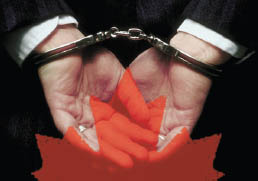Canadian crime rate drops, but still $85 Billion cost to taxpayer
The Fraser Institute
Despite a decline in the crime rate, crime cost Canadians $85 billion in 2009 (the latest year with comprehensive data) including $47 billion incurred by crime victims, finds a new study released today by the Fraser Institute, an independent, non-partisan Canadian public policy think-tank.
The study, The Cost of Crime in Canada: 2014 Report, measures the overall costs of police, courts, prisons, rehabilitation and education. And the varied costs incurred by crime victims due to stolen or damaged property, crime prevention, lost health and productivity, and less tangible costs associated with anger, frustration and fear.
“Unfortunately crime is a fact of life, but to understand whether we spend too little or too much on fighting crime, we need to understand the full costs,” said Stephen Easton, Fraser Institute senior fellow, professor of economics at Simon Fraser University, and lead author of the study.
Although the Canadian crime rate fell 27 per cent between 2002 and 2012, crime costs increased dramatically.
For example, policing costs jumped 43 per cent from $8 billion in 2002 to $11.5 billion in 2012, while corrections costs (prison, parole, etc.) rose 32 per cent from $3.6 billion to $4.8 billion over the same period.
Additionally, the cost of legal aid for people who can’t afford legal representation in criminal cases rose from $322.1 million (2012 dollars) in 2002 to $430.7 million in 2012.
The study also found that while the number of criminal cases completed in Canadian courts over the past 15 years has remained relatively stable, the proportion of cases taking more than a year to complete doubled from eight per cent to more than 16 per cent.
For example, the proportion of homicide cases that took more than a year to complete rose from 10 per cent in 1994/95 to 49 per cent in 2009/10.
“The costs of crime are rising in part because the Supreme Court of Canada has imposed a set of evolving requirements on the police and prosecutors that make it more expensive to capture and prosecute criminals,” Easton said.
While the study examines the overall cost of crime in Canada, it pays special attention to crime victims, outlining victim profiles based on crime statistics.
For example, the average age of a violent crime victim is 32. Approximately 50 per cent of attempted murder and robbery victims are under the age of 24. Most other violent crimes and property crimes (i.e. vehicle theft) disproportionately affect Canadian males (for example, 64 per cent of assault victims are male), yet approximately 72 per cent of sexual assault victims are female.
“As Canadians, we must ensure that our criminal justice system works fairly and efficiently—crime victims deserve nothing less,” Easton said.
“When making spending decisions on crime prevention, prosecution and punishment, governments across Canada need to clearly understand the potential effect of those decisions, for the sake of taxpayers, crime victims and their families.”
























